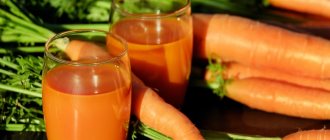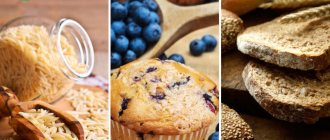The essence of separate nutrition
Foods have different chemical compositions, which affects the rate of digestion in the body. For example, fruits are digested in 30 minutes, and meat in 6-8 hours. The main goal of separate nutrition is to organize the consumption of foods with different periods of digestion at different meals.
According to supporters of this system, food that is delayed longer than expected can cause adverse processes in the gastrointestinal tract. In addition, it is assumed that foods that require different enzymes for digestion should be separated, because otherwise the food may not be digested and will lose its value.
Buckwheat: proper nutrition
The following nutritional information is provided for 168 g of plain cooked buckwheat:
- Calories: 155
- Fat: 1 g
- Sodium: 252 mg
- Carbohydrates: 33 g
- Fiber: 4.5 g
- Sugar: 1.5 g
- Protein: 5.7 g
Carbohydrates
. As a grain alternative, buckwheat is still high in carbohydrates, with 33 grams per serving of cooked buckwheat. Buckwheat flour is more concentrated, containing about 44 grams of carbohydrates per 1/2 cup. Buckwheat is naturally low in sugar and high in fiber. The glycemic index of buckwheat is 49, and the glycemic load is 15 (based on 150 g serving).
Fats
. When figuring out how to eat buckwheat in a healthy diet, it is important to remember that this crop is naturally low in fat, only 1 gram per serving, and most of the fats in buckwheat are heart-healthy unsaturated fats.
Protein
. When it comes to protein content, buckwheat puts most grains to shame, with cooked buckwheat containing 5.7 grams of protein per cup (about twice as much protein as oatmeal). Unusual for a plant food, buckwheat has a complete amino acid profile, meaning it contains all the essential amino acids our bodies require from food. When determining how to eat buckwheat in a healthy diet, keep in mind that this grain is an excellent addition to any healthy eating plan, but can be especially beneficial for vegetarians looking to increase their protein intake.
Vitamins and minerals
. Buckwheat is rich in B vitamins and minerals: niacin (used in the digestive system, skin and nerves) and vitamin B2 (riboflavin) are especially abundant in buckwheat.
Buckwheat also contains:
- magnesium (supports muscle health);
- phosphorus (used to form teeth and bones);
- zinc (important for the immune system);
- copper (helps the body produce collagen and absorb iron);
- manganese (helps in building connective tissue and bones).
With so many nutrients, buckwheat truly promotes health.
Benefit for health
Buckwheat has a number of health benefits, especially for the digestive system. If you have certain dietary restrictions or digestive problems, buckwheat can be a versatile addition to your menu.
Useful for people with celiac disease. Pure buckwheat does not contain gluten. Buckwheat is often used to produce foods that are labeled gluten, especially cereals. However, if you must follow a gluten-free diet, don't assume that a food item is gluten-free just because it contains buckwheat—always read the label for gluten-free certification.
Helps cope with irritable bowel symptoms. Buckwheat's nutrient density makes it an excellent choice for those who must follow a restrictive eating plan. Pure buckwheat is also low in FODMAPs, which are types of carbohydrates that can worsen digestive problems in some people. Dietitians often recommend a low-calorie diet for people with irritable bowel syndrome (IBS); temporarily eliminating FODMAPs may also help identify foods that are causing symptoms.
Controls blood sugar levels. A study comparing a buckwheat-consuming region in Mongolia with a region where no buckwheat is consumed found that the population that eats buckwheat has almost 17% lower fasting blood sugar levels. Buckwheat's low glycemic rating, along with the beneficial polyphenols it contains, are two reasons for those with diabetes to consider adding it to their food list (especially in place of sugary cereals and refined grains).
Reduces cholesterol levels. Buckwheat has been shown to have many cardiovascular benefits. Consumption of buckwheat reduced total cholesterol by an average of 0.5 mmol/L and triglycerides by 0.25 mmol/L, based on data from human studies ranging from seven days to 27 weeks of testing. This is likely due in part to its resistant starch content.
Prevents diverticular diseases. When choosing what you can eat buckwheat with with proper nutrition, remember that its grain contains mainly insoluble fiber. This is a type of fiber that does not dissolve in water, meaning that it remains largely intact as it moves through the digestive tract. Insoluble fiber helps increase stool bulk, curbing constipation and reducing the risk of diverticulitis, a painful infection in the large intestine. Health authorities recommend that adults get between 20 and 35 grams of fiber per day—eating 3/4 cup of buckwheat as a hot cereal for breakfast will get your day off to a great start!
Advantages of separate power supply
The diet is based on the consumption of natural products with minimal processing. Semi-finished products, fast food, sugar are not recommended. Those. the body receives only useful substances that saturate well, while the caloric content of the diet is reduced, which promotes weight loss.
The selection of products is carried out consciously and thoughtfully, which develops the skill of meal planning.
It is not difficult to formulate a diet; many foods are allowed, from which it is easy to prepare delicious dishes. When switching to this regime, no radical changes in eating habits are required.
With separate meals, most foods are allowed to be consumed.
Combination of products: basic principles according to Ayurveda
There are three factors that determine the properties of food. These are taste (rasa), energy of heating or cooling (virya) and the effect that occurs after digestion (vipak). When two foods with different flavors, energy and post-digestive effects are combined, it can overload the agni. Just as a medicine taken outside the instructions can become poisonous, some foods can become toxic when combined incorrectly. Combining incompatible foods weakens the entire gastrointestinal tract, can cause fermentation, lead to gas, bloating and ultimately lead to a buildup of toxic substances (ama).
Agni is responsible not only for the digestive system. Its condition signals the body's ability to eliminate waste and the strength of the immune system. Therefore, if incompatible food combinations are consumed for a long time, the functioning of agni is disrupted.
For example, according to Ayurveda, bananas and milk should not be mixed. Although both foods have a sweet taste and provide a cooling energy, bananas have a sour post-digestive effect while milk has a sweet post-digestive effect. As a result, the digestive system malfunctions and causes changes in intestinal flora, producing toxins, leading to nasal congestion, cold or allergy symptoms.
Another example is beans and cheese. Both beans and cheese are difficult for the human body to digest. Both products require good digestion and have different properties, which interferes with the absorption of nutrients at the cellular level. If beans and cheese are eaten together, they quickly weaken the digestive fire.
Another striking example of product incompatibility is milk and fruit. Paradoxically, this is one of the most common combinations for breakfast and lunch on the table of a modern person. Surely, at least once in your life you have added chopped bananas and other fruits to milk porridge or yogurt. This combination leads to a deterioration in health and manifests itself in the form of frequent colds and other symptoms of kapha dosha imbalance.
And all because these products have different qualities. When bananas break down in the body, they become sour. You probably know that if you add lemon to milk, it will curdle. This happens to our digestion when we combine foods incorrectly.
Let's take a closer look at common food combinations that are best avoided.
Milk
It should not be combined with any products. Drink it only warmed up, with the addition of ghee (optional). You can add honey if the milk is not very hot. Dairy products and fruit are not a good combination.
Fruits
Best eaten on its own. This is especially true for melon. Eat fruit 20 minutes before eating other foods and in small quantities if they are raw.
Beans
Avoid eating beans with fruit, dairy products and animal proteins. Beans are best consumed with vegetables, nuts and grains.
Bread
Best eaten separately from other foods. Bread made from refined flour causes problems due to the large amount of gluten, which is difficult to digest. The healthiest bread is made from whole grain flour, such as spelled, or with traditional sourdough.
Raw and cooked foods
Cooked foods are easier to digest than raw foods, so they should be eaten separately.
Disadvantages of the system
One of the disadvantages is the difficulty of planning a menu if family members do not share the same view on a given food system.
You will have to spend extra time cooking separately for yourself and others. Difficulties may arise when participating in joint feasts with friends and relatives, because... On holidays, tables are set with dishes made from mixed ingredients. This nutritional system is not supported in modern medicine.
According to nutritionists, eating foods separately can disrupt the normal, habitual process of digestion. Since ancient times, people have eaten different foods; the gastrointestinal tract, in the process of evolution, has completely adapted to digesting any food. If you strictly follow the rules of separate nutrition for a long period, then the digestive organs will no longer cope with many dishes (dumplings, pies, borscht, etc.). In addition, this system itself does not affect weight loss, because... Overeating is possible when eating simple, natural food. Reducing calorie intake helps you lose weight.
Does buckwheat alkalize or oxidize the body?
Since for many of those who have problems with the digestive tract, it is important to monitor the level of acidity, it will be important to find out whether buckwheat alkalizes or oxidizes the body. So, this culture increases the pH level in the body, having a moderate alkalizing effect on it.
Although a buckwheat allergy is possible, it is considered rare. Symptoms of a buckwheat allergy may include hives, swelling of the tongue and lips, and difficulty breathing. If you are trying buckwheat porridge for the first time and experience these symptoms, immediately seek medical help and also start looking for something to replace buckwheat with proper nutrition.
Varieties
There are several ways to enjoy buckwheat porridge. Buckwheat flour is used to make pancakes, pancakes, buns, scones and cookies. Sauces, soups and casseroles can be thickened with buckwheat flour as a gluten-free alternative to wheat flour. In Japan, buckwheat flour is mixed with wheat flour to make soba noodles.
Cereals are buckwheat kernels with the shell removed. Various cuisines around the world use buckwheat in their main dishes. Noodles, chapatti and dumplings are made from buckwheat in Asia; In Europe, toasted buckwheat is called “porridge”, which is used in pilaf and meat dishes - variations on the topic of what buckwheat goes with in a healthy diet.
With the rise in demand for gluten-free foods, you can find crackers, muesli and other processed foods made from buckwheat. While buckwheat is a healthy ingredient, remember that these products may contain added sodium, sugar and preservatives. When it comes to food, the less processed it is, the more nutritious it usually is; the same applies to buckwheat products.
Buckwheat, like other whole grains, is subject to the same general food safety guidelines. Intact whole grains should always be stored in an airtight container, as moisture, heat and air will cause them to decompose. Buckwheat can be stored this way in the pantry for two months and in the freezer for up to one year. Buckwheat flour or meal should be stored in the pantry for one month and in the freezer for two months. Cooked grains will keep for about three to four days in the refrigerator, but when in doubt, throw them out.
Weight Loss Products
Check out the following 10 food combinations. Their use in the daily diet will lead to weight loss and maintain health.
Vegetables + hard-boiled eggs
According to one study, eggs help absorb carotenoids (the pigments that give vegetables their color).
Carotenoids not only help fight excess weight. They prevent vision loss, reduce the risk of cancer, and also help nourish the skin.
So the next time you decide to make a vegetable salad, add boiled eggs to the mixture.
Tuna + ginger
Ginger speeds up bowel movements and blocks enzymes that contribute to inflammatory processes in the human body.
Tuna contains a type of Omega-3 that prevents the accumulation of fat in the belly area.
Therefore, tuna + ginger is an ideal combination if you want to get rid of extra pounds.
Corn + beans
Studies have shown that a diet that includes legumes once a week is more effective for weight loss than the same diet with exactly the same number of calories but no legumes.
And adding corn to your diet increases the weight loss effect. Corn contains starch, which makes the body unable to absorb most calories and glucose.
Spinach+avocado oil
These two superfoods may be your new appetite suppressant allies.
The oil contained in avocados regulates cholesterol levels and contains vitamins B and E and potassium.
Spinach increases saturation of the body and, at the same time, contains a low amount of calories.
A more substantial meal is chicken salad with avocado. Such food keeps sugar at the right level, fills the body with energy and essential nutrients.
Melon + red grapes
Melon is a natural diuretic. It prevents fluid retention in the body.
Grapes contain an antioxidant that helps reduce fat accumulation.
Together, these two products are the perfect combination to prevent puffiness and fat accumulation.
Chicken + cayenne pepper
Like any protein-rich food, chicken helps you feel fuller longer and also helps you eat fewer calories at subsequent meals.
Cayenne pepper, in turn, accelerates fat burning and suppresses appetite.
Salmon and asparagus
Salmon contains healthy omega-3 acids, and asparagus is rich in fiber and protein, and also helps remove excess water from the body.
Bake the dish in the oven or steam it - it will turn out both tasty and healthy.
Almonds and Greek yogurt
The combination of fat and protein stabilizes the body and regulates blood sugar levels. Plus you feel full. In addition, some vitamins (especially A, D and E) are best absorbed when they are consumed along with fats.
One such successful combination is considered to be: nuts and yogurt. For example, almonds are a source of calcium, antioxidants and vitamin E, and fat-filled Greek yogurt is rich in vitamin 0. The perfect combination!
Green tea and lemon juice
Green tea contains catechins, which are powerful antioxidants.
Everyone knows about the beneficial properties of lemon, but another advantage of citrus fruits is that they can reduce the breakdown of catechins, making them even more easily digestible.
Coffee+cinnamon
Cinnamon contains powerful antioxidants that reduce belly fat.
Coffee reduces appetite. So if you're trying to shed those unwanted pounds, there's nothing better than starting your day with a delicious cup of cinnamon-flavored coffee.
Now that you know which food combinations help you lose excess weight, pay attention to the following combinations that you should avoid:











